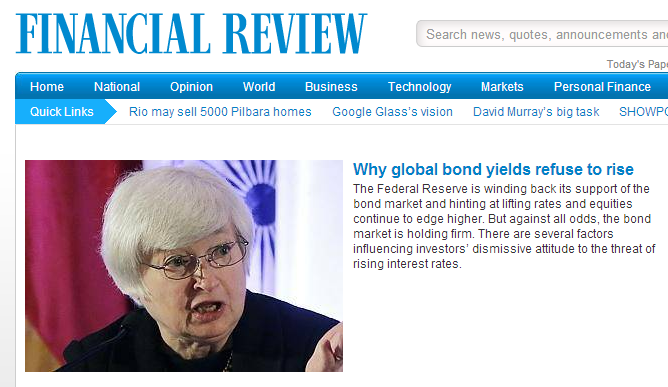
The shortcoming of “he said, she said” journalism are on display at the AFR as we speak with its lead article by Jonathon Shapiro on US bonds largely wrong:
…why are bond yields still so low? Why are investors so dismissive of the threat of rising interest rates?
There’s no obvious answer but there are several contributing factors, according to Damian Mcoulough of head of interest rates strategy at Westpac.
One is that the market is still undecided about the fate of the US economy and how much of a factor bad weather played in the recent spate of weak data. Until there is greater clarity investors are reluctant to sell bonds.
Wrong. Short term bond yields are in no doubt about the Fed’s intentions or that the economy is going to rebound after the winter. 2 and 5 year Treasuries have sold off heavily since Janet Yellen accelerated taper expectations and they are still trending down.
It is long bonds that have been bid and that is not about the weather, it is about the long term prospects for the economy as short term rates rise. This process is known as curve flattening and is generally considered a bearish signal for long term growth. At its most extreme this process can culminate in an “inverted yield curve” – when short term rates are higher than long term – which is a very reliable predictor of recession, though we’re a long way from that at the moment. Back to Shapiro:
Also shorting bonds is not that cheap. Even when they yield 2.72 per cent the cost of funding a short position in bonds means investors need to get the timing right.
Mcoulough adds that geopolitical factors – while the overriding factor– cannot be discounted. Even as equity markets edge higher there are still a safe-haven bid for bonds.
Wrong. The first point is irrelevant. If markets think bonds should be shorted they’ll short ’em. On geopolitics, yes, there is probably a safe haven bid, but there are also big outflows, as we’ve seen with very large Russian capital repatriation. There is no certainty about which is the larger influence right now.
For Australia, Shapiro makes a simple point:
Another factor is that the so-called carry trade is alive and well. Investors are still searching higher yields either in long term bonds or in higher yielding markets such as Australia.
The rising Australian dollar is making the carry traders more confident that it will be harder for the RBA to raise interest rates too much and catch them out.
That’s true enough, though it has its limits. Push too far and the RBA will cut, dropping the dollar and pushing capital loses onto the foreign bond holders, which are usually un-hedged.
The bigger macro reason why long bond yields aren’t rising is straight forward. There’s no inflation in the US or Europe or China and with the latter’s rebalancing, commodity deflation is also likely to continue.

